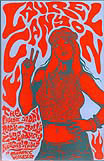|
"Laurel Canyon: The Inside Story of Rock and Roll's Legendary Neighborhood" by Michael Walker explores the spontaneous musical renaissance that occurred in the Hollywood Hills of Los Angeles in the '60s. Spontaneous in that it was a true "happening" - this little colony of creativeness could have only started in the '60s, when the idealism of the young musicians had yet to be disillusioned by drugs, the Manson murders and Altamont. This book not only covers the golden years of Laurel Canyon starting in 1964, but also follows it through its zenith in 1981. The wake-up call of the Wonderland Murders in 1981 effectively put the final nail in the coffin of Laurel Canyon; much like the Manson murders and Altamont did to the '60s idealism.
By covering 1964-1981, the reader is almost struck by a sense of sadness as the once creative utopia of Laurel Canyon slowly disintegrates before their eyes in this sometimes-tragic tale. Walker's telling of the Laurel Canyon story is almost a microcosm for the '60s in general. The influence of drugs is explored, first as an experimental offshoot, until finally the scourge of cocaine slowly creeps in during the '70s. Within a social context, the Manson murders are examined, if only to show the effect on the mindset of the neighborhood almost overnight. Speaking of the Manson section - this is where I found the first of only two errors I found in the book - it is stated that the body of one time Manson family attorney Ronald Hughes was never found. He body was in fact found, but so badly decomposed that the cause of death could not be found. Manson family legend has it that the Hughes "murder" was the first of the "retaliatory murders". [I know, I'm knit picking, but I'm very knowledgeable about the Manson case and errors about it seem to jump out at me.] The other error is that Terry Melcher is called the "producer" of the Beach Boys - he was not their producer, but instead followed in the same social circles as the group, especially with Beach Boys drummer Dennis Wilson, who like Melcher shared a connection with Charles Manson.
Of course, my favorite part of the book is the section that focuses on the golden age of Laurel Canyon: from the Byrds, Frank Zappa, the Mamas and the Papas, etc - and the camaraderie that happened and the timeless songs that resulted. The interviews with Graham Nash, Gail Zappa, Pamela DeBarres and Chris Hillman are especially revealing. Hillman gives hindsight as to when the "rot" set in and ended the lives of so many young musicians, not to mention the premature demise of the Byrds. Not having done drugs, Gail Zappa had a unique perspective on things. Graham Nash gives the best telling of the songs that were written at Laurel Canyon. Crystal Brelsford recounts a hilarious story of how she was on acid when Brian Wilson asked if he could shave her legs! The best story, which is also indicative of the spontaneous nature of Laurel Canyon, is how Mama Cass Elliot facilitated the formation of Crosby, Stills and Nash - she just KNEW they would sound great together, she made them get together, and history was born.
Not only is "Laurel Canyon: The Inside Story of Rock and Roll's Legendary Neighborhood" a fascinating and in-depth story of the Laurel Canyon saga, but it is also parallels the story of the rise and fall of the '60s mythos factually - and most importantly, without trying to interject politics where it had no influence or effect whatsoever. Too many authors try to re-write rock and roll history with a spin of their own political agenda. This book is truly a rock and roll classic - and required reading for "Rock and Roll History 101"!
|

 "Laurel Canyon: The Inside Story of Rock and Roll's Legendary Neighborhood"
"Laurel Canyon: The Inside Story of Rock and Roll's Legendary Neighborhood"